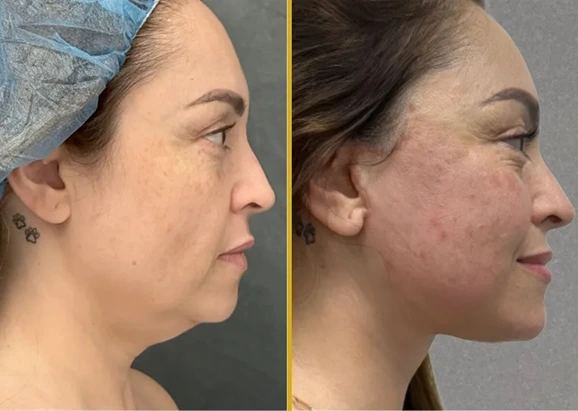In Miami, neck lift procedures are becoming increasingly popular as more and more people seek practical solutions to counter the signs of neck aging and enhance their aesthetic appeal. This vibrant city, known for its dynamic culture and high beauty standards, is home to the esteemed Revive Surgical Institute, where Dr. Askari and Dr. Gerth are the lead plastic surgeons. Known for their advanced techniques and exceptional skill, our surgeons specialize in tightening sagging skin, reducing wrinkles, and eliminating excess fat around the neck. The result is a youthful and more refined look.


A neck lift, also called lower rhytidectomy or neck rejuvenation, is a surgical procedure designed to enhance the appearance of the neck by addressing signs of neck aging, such as sagging skin, excess fat, and muscle laxity. It involves tightening the neck muscles, removing or redistributing excess fat, and repositioning or removing loose skin to create a more defined neck contour. In addition, neck lifts can address issues like double chin, jowls, neck bands, and a “turkey neck” appearance. This procedure aims to rejuvenate the neck area, resulting in a smoother, firmer, and more youthful appearance.
The neck lift procedure can benefit individuals experiencing signs of skin aging or who have lost weight and are dealing with excess neck skin. This surgery typically involves the following steps:
A neck lift consultation with our board-certified surgeon is the initial step in the procedure. You can discuss your goals and concerns during this meeting. Our surgeon will assess your medical history, perform a thorough physical examination of your neck, and engage in a comprehensive discussion to understand your desired look. Our surgeon will then provide expert insights and offer various options tailored to your needs, allowing you to make informed decisions about achieving your aesthetic goals.
Before the procedure begins, you will be given anesthesia to ensure that you are relaxed and pain-free. Both local anesthesia with sedation and general anesthesia are commonly used for neck lift surgery, and the preference may vary depending on our recommendation and your needs.
Once the incisions are made, we carefully remove any excess skin, preserving the natural contours of the neck. After the skin has been removed, our surgeon may tighten weak muscles in the neck to improve the shape and firmness of the neck and jawline, typically done by making incisions in the platysma muscle, which is the thin muscle that covers the neck. We tighten vertical bands to create a more defined jawline and smoother neck contour. After removing muscle banding, excess skin, and fatty deposits, our surgeons proceed to the final stage of the procedure.
We will carefully suture the incision using specialized techniques to minimize scarring and ensure proper healing. Sometimes, to aid in reducing swelling and fostering healing in the affected area, we may insert a drain.
Recovery times can change depending on the degree of the surgery and the patient’s health. Most individuals usually resume normal activities within two weeks of surgery, including returning to work. For a few weeks, you can expect some neck stiffness. Here is the typical recovery timeline:

Facelift surgery is a natural complement to a neck lift, especially for individuals with visible signs of aging across the mid-to-lower face. When poor skin elasticity affects not only the neck but also the cheeks and jawline, combining facial surgery with a neck lift can produce more comprehensive rejuvenation. This procedure involves tightening deeper facial tissues and removing excess skin, creating a firmer, more youthful appearance. In some cases, laser skin resurfacing may also be recommended to improve skin tone and texture, enhancing the overall outcome.
Facial fat grafting is a cosmetic procedure that involves transferring purified fat from one area of your body to areas of the face that have lost volume. This treatment is particularly effective in restoring youthful contours to the cheeks, temples, and under-eye regions. By combining fat grafting with a neck lift, patients achieve a more harmonious and naturally refreshed appearance. It is ideal for individuals seeking volume restoration without relying on synthetic fillers.
A jaw augmentation procedure can further define the lower face when performed alongside a neck lift. While the neck lift offers skin tightening and contour improvement, adding jaw augmentation creates a more angular, youthful look by enhancing bone structure. In Miami, plastic surgeons often recommend this combination for individuals seeking bold, long-lasting improvements to their jawline and neck. Together, these procedures contribute to a more balanced and sculpted appearance.

The ideal neck lift candidate wants to enhance the appearance of their neck and desires a more youthful and defined neck contour. Candidates for a neck lift should have the following characteristics:
Individuals must be in good physical condition and without any underlying health issues that may pose a threat during the surgical procedure.
Smoking may increase the risk of complications during and after neck lift surgery and have an adverse effect on the healing process. Therefore, before and during the treatment, candidates should abstain from smoking.
Schedule a consultation to explore how a facelift can restore youthful contours with natural, graceful results.
Neck rejuvenation surgery can improve the appearance of the jawline and aging neck by tightening the skin and the muscles underneath. Some of the benefits of neck lifts may include the following:
The surgery can reduce the appearance of neck aging, such as wrinkles, sagging neck skin, double chin, and jowls, creating a more youthful and refreshed appearance.
Neck lift cost in Miami typically ranges from $5,000 to $20,000, with the median price hovering between $5,000 and $6,000. However, it is important to remember that these prices often incorporate a variety of costs besides the surgeon’s fee, including anesthesia, facility fees, and post-operative care expenses, such as follow-up appointments.
The final price tag of a neck lift procedure in Miami can fluctuate based on several variables. The surgeon’s expertise and reputation, the complexity of the surgery, anesthesia and facility fees, any necessary pre-operative tests (such as blood work or imaging), and care all contribute to the overall cost. Sought-after plastic surgeons usually charge higher fees due to their advanced skills and experience.
If affordability is a concern, medical credit cards like CareCredit or Alphaeon Credit could be a viable option. These cards, designed specifically for health-related expenses, often offer a range of payment plans and interest rates, potentially making the cost of the procedure more manageable.
Choosing Revive Surgical Institute for your neck lift procedure offers several significant advantages, many of which can be attributed to our surgeons’ exceptional skill and expertise.
As board-certified plastic surgeons at Revive Surgical Institute, Dr. Askari and Dr. Gerth are highly regarded for their advanced surgical techniques and meticulous attention to detail. Their dedication to achieving the best possible results for their patients is evident in the consistently high level of patient satisfaction. With their board certifications, Dr. Askari and Dr. Gerth have demonstrated expertise and competence in plastic surgery, making them a trusted choice for individuals seeking exceptional outcomes at Revive Surgical Institute.